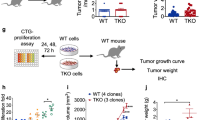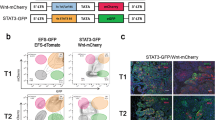Abstract
Nuclear-targeted high molecular weight 24 kDa fibroblast growth factor 2 (FGF-2) may induce specific cell functions through intracrine mechanisms. The role of nuclear FGF-2 on the metastatic potential of carcinoma cells was examined by conditional FGF-2 expression, which demonstrated that spontaneous metastasis in nude mice is a direct consequence of its expression. The lung colonizing capacities of fluorescent nuclear FGF-2-expressing cells following intravenous injection was also investigated. All cells reaching the lung extravasated as soon as 5 min following injection with similar in vivo behavior during the first 24 h. However, after 2 days, dramatic differences were observed between the FGF-2 and parental cells: most control cells underwent apoptosis, while the FGF-2-producing cells instigated a survival program and proliferated. Therefore, sustained apoptosis in vivo prevents growth of metastatic foci, while nuclear FGF-2 induction of a survival program is responsible for growth of the lung metastases. In vitro serum deprivation assays also established that 24 kDa FGF-2 expression improves carcinoma cell survival. This study provides both in vitro and in vivo evidence that the role of the nuclear 24 kDa FGF-2 isoform in carcinoma is the promotion of cell survival, thereby defining its association with poor prognosis in some human carcinomas.
This is a preview of subscription content, access via your institution
Access options
Subscribe to this journal
Receive 50 print issues and online access
$259.00 per year
only $5.18 per issue
Buy this article
- Purchase on Springer Link
- Instant access to full article PDF
Prices may be subject to local taxes which are calculated during checkout






Similar content being viewed by others
References
Al-Mehdi AB, Tozawa K, Fisher AB, Shientag L, Lee A and Muschel RJ . (2000). Nat. Med., 6, 100–102.
Arnaud E, Touriol C, Boutonnet C, Gensac MC, Vagner S, Prats H and Prats AC . (1999). Mol. Cell. Biol., 19, 505–514.
Boelaert K, McCabe CJ, Tannahill LA, Gittoes NJ, Holder RL, Watkinson JC, Bradwell AR, Sheppard MC and Franklyn JA . (2003). J. Clin. Endocrinol. Metab., 88, 2341–2347.
Bold RJ, Virudachalam S and McConkey DJ . (2001). Cancer, 92, 1122–1129.
Bugler B, Amalric F and Prats H . (1991). Mol. Cell. Biol., 11, 573–577.
Cameron MD, Schmidt EE, Kerkvliet N, Nadkarni KV, Morris VL, Groom AC, Chambers AF and MacDonald IC . (2000). Cancer Res., 60, 2541–2546.
Chao DT and Korsmeyer SJ . (1998). Annu. Rev. Immunol., 16, 395–419.
Delrieu I . (2000). FEBS Lett., 468, 6–10.
Farina KL, Wyckoff JB, Rivera J, Lee H, Segall JE, Condeelis JS and Jones JG . (1998). Cancer Res., 58, 2528–2532.
Fukui S, Nawashiro H, Otani N, Ooigawa H, Nomura N, Yano A, Miyazawa T, Ohnuki A, Tsuzuki N, Katoh H, Ishihara S and Shima K . (2003). Cancer, 97, 3061–3067.
Fukui S, Otani N, Nawashiro H, Yano A, Miyazawa T, Ohnuki A, Tsuzuki N, Katoh H, Ishihara S, Suzuki T and Shima K . (2002). J. Neurooncol., 57, 221–229.
Funato N, Moriyama K, Shimokawa H and Kuroda T . (1997). Biochem. Biophys. Res. Commun., 240, 21–26.
Gaubert F, Escaffit F, Bertrand C, Korc M, Pradayrol L, Clemente F and Estival A . (2001). J. Biol. Chem., 276, 1545–1554.
Giavazzi R, Giuliani R, Coltrini D, Bani MR, Ferri C, Sennino B, Tosatti MP, Stoppacciaro A and Presta M . (2001). Cancer Res., 61, 309–317.
Gossen M and Bujard H . (1992). Proc. Natl. Acad. Sci. USA, 89, 5547–5551.
Gualandris A, Arese M, Shen B and Rifkin DB . (1999). J. Cell. Physiol., 181, 273–284.
Hajihosseini MK and Dickson C . (1999). Mol. Cell. Neurosci., 14, 468–485.
Karsan A, Yee E, Poirier GG, Zhou P, Craig R and Harlan JM . (1997). Am. J. Pathol., 151, 1775–1784.
Konig A, Menzel T, Lynen S, Wrazel L, Rosen A, Al-Katib A, Raveche E and Gabrilove JL . (1997). Leukemia, 11, 258–265.
Koop S, MacDonald IC, Luzzi K, Schmidt EE, Morris VL, Grattan M, Khokha R, Chambers AF and Groom AC . (1995). Cancer Res., 55, 2520–2523.
Luzzi KJ, MacDonald IC, Schmidt EE, Kerkvliet N, Morris VL, Chambers AF and Groom AC . (1998). Am. J. Pathol., 153, 865–873.
Maloof P, Wang Q, Wang H, Stein D, Denny TN, Yahalom J, Fenig E and Wieder R . (1999). Breast Cancer Res. Treat., 56, 153–167.
Miyake H, Hara I, Yamanaka K, Gohji K, Arakawa S and Kamidono S . (1999). Br. J. Cancer, 79, 1651–1656.
Naumov GN, Wilson SM, MacDonald IC, Schmidt EE, Morris VL, Groom AC, Hoffman RM and Chambers AF . (1999). J. Cell Sci., 112, 1835–1842.
Okada-Ban M, Moens G, Thiery JP and Jouanneau J . (1999). Oncogene, 18, 6719–6724.
Okada-Ban M, Thiery JP and Jouanneau J . (2000). Int. J. Biochem. Cell. Biol., 32, 263–267.
Pardo OE, Arcaro A, Salerno G, Raguz S, Downward J and Seckl MJ . (2002). J. Biol. Chem., 277, 12040–12046.
Pardo OE, Lesay A, Arcaro A, Lopes R, Ng BL, Warne PH, McNeish IA, Tetley TD, Lemoine NR, Mehmet H, Seckl MJ and Downward J . (2003). Mol. Cell. Biol., 23, 7600–7610.
Powers CJ, McLeskey SW and Wellstein A . (2000). Endocr. Relat. Cancer, 7, 165–197.
Rosini P, Bonaccorsi L, Baldi E, Chiasserini C, Forti G, De Chiara G, Lucibello M, Mongiat M, Iozzo RV, Garaci E, Cozzolino F and Torcia MG . (2002). Prostate, 53, 310–321.
Savagner P, Valles AM, Jouanneau J, Yamada KM and Thiery JP . (1994). Mol. Cell. Biol., 5, 851–862.
Sun G, Doble BW, Sun JM, Fandrich RR, Florkiewicz R, Kirshenbaum L, Davie JR, Cattini PA and Kardami E . (2001). J. Cell. Physiol., 186, 457–467.
Takaoka A, Adachi M, Okuda H, Sato S, Yawata A, Hinoda Y, Takayama S, Reed JC and Imai K . (1997). Oncogene, 14, 2971–2977.
Toyoshima K, Ito N, Hiasa Y, Kamamoto Y and Makiura S . (1971). J. Natl. Cancer Inst., 47, 979–985.
Van den Berghe L, Laurell H, Huez I, Zanibellato C, Prats H and Bugler B . (2000). Mol. Endocrinol., 14, 1709–1724.
Wert MM and Palfrey HC . (2000). Biochem. J., 352 (Part 1), 175–182.
Wieder R, Wang H, Shirke S, Wang Q, Menzel T, Feirt N, Jakubowski AA and Gabrilove JL . (1997). Growth Factors, 15, 41–60.
Wong CW, Lee A, Shientag L, Yu J, Dong Y, Kao G, Al-Mehdi AB, Bernhard EJ and Muschel RJ . (2001). Cancer Res., 61, 333–338.
Acknowledgements
We would like to thank C Bonneton for the NBT-II Tet-Off cells and MF Poupon for nude mouse injections. This work was supported by the Centre National de la Recherche Scientifique and the Institut Curie, by Grants (ARC-9477 and ARC-5902 to JJ) and a postdoctoral fellowship (RT-M) from the Association pour la Recherche sur le Cancer, the Groupement des Entreprises Françaises contre le Cancer (Gefluc) and a fellowship from the National Health and Medical Research Council, Australia (RT-M, ID 247950).
Author information
Authors and Affiliations
Corresponding author
Rights and permissions
About this article
Cite this article
Thomas-Mudge, R., Okada-Ban, M., Vandenbroucke, F. et al. Nuclear FGF-2 facilitates cell survival in vitro and during establishment of metastases. Oncogene 23, 4771–4779 (2004). https://doi.org/10.1038/sj.onc.1207638
Received:
Revised:
Accepted:
Published:
Issue Date:
DOI: https://doi.org/10.1038/sj.onc.1207638
Keywords
This article is cited by
-
Nuclear basic fibroblast growth factor regulates triple-negative breast cancer chemo-resistance
Breast Cancer Research (2015)
-
Transplantation of Mouse Embryonic Stem Cells into the Cochlea of an Auditory-Neuropathy Animal Model: Effects of Timing after Injury
Journal of the Association for Research in Otolaryngology (2008)
-
Nuclear trafficking of secreted factors and cell-surface receptors: new pathways to regulate cell proliferation and differentiation, and involvement in cancers
Cell Communication and Signaling (2006)



